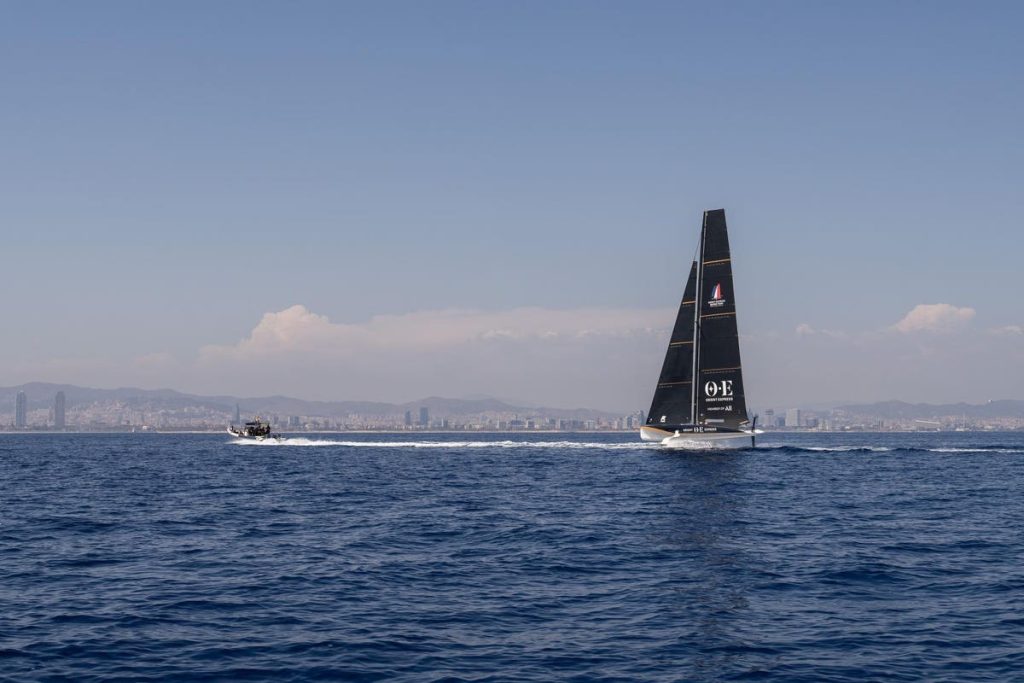The 37th America’s Cup sailing race will take place in the year 2024 in Barcelona, Spain. However, the first of three preliminary regattas before that event has kicked off in Vilanova i la Geltrú, a coastal city some 30 coastal miles [50 kilometers] south of Barcelona. Out of six racing teams from New Zealand, the U.S., U.K, Switzerland, Italy and France, the French Orient Express team cooly breezed into a win on the first competitive event on a hot 85 degree [29 Celsius] Saturday mid-afternoon.
The French win was unexpected because the team was the last to enter the race, resulting in members not having extensively trained together on the seas. They did, however, manage to work together on a simulator boosted with artificial intelligence inputs.
Although Friday was scheduled as the first day of racing, torrential rains cancelled all events. The first race took place on Saturday instead.
Hours before the event, Stephan Kandler, Team-Principal for the Orient Express Racing Team and founder of K-Challenge—together with Bruno Dubois—provided insights into how unique this race is compared to events held during previous decades.
‘The interiors of the boats have no ropes. No winches. We are like Formula 1 teams and the new generation of pilots must fly in these boats. And once you are flying, you need to stay flying all the time.’
Kandler is literal with the word flying. Aerofoils on these boats transform horizontal movement through water into vertical lift—in the same way that an airplane wing pushes the craft upward into the sky. The lift is so pronounced, the designs so hydrodynamic and aerodynamically fine tuned, the construction materials so light, that the bulk of these boats now rise out of the water and fly through the air during a race.
The four person teams wear helmets, goggles and microphones—replacing the scarved and capped image of skippers from past decades with the avatar of pilots.
For the initial two regattas—first here in Spain and second to be held in Jeddah, Saudi Arabia in November and December this year, the boats being used are known as AC40’s—basically monohull boats built to identical ‘one design’ specifications with hulls 37 feet [11.3 meter] long and masts 59 feet [18 meters] tall; they can reach top speeds of over 45 knots.
The America’s Cup race began in 1851 and is considered the oldest trophy for any international sport. Races are typically held every three or four years and only four nations have ever won: the U.S., Australia, Switzerland and New Zealand. The last winner in 2021 was Emirates Team New Zealand—now defender of the cup.
The 2024 race will take place off the coast of Barcelona, and the boats to be used for this race—known as AC75’s—are still being constructed. Their final designs will likely be modified based on results from these initial regattas.
When asked when the engineering design for a new boat is completed, Chief Designer for the Orient Express team, Benjamin Muyl, replied: ‘On the morning of the final race.’ This is because technical improvements are iterative, and data from each race supplies information to improve future designs of foils and forms.
Orient Express Team Skipper Quentin Delapierre—perhaps best referred to as Pilot Delapierre, considering the aerodynamic nature of these craft—summarized the win modestly, saying simply that the French team ‘Tried to follow our feeling.’ The confluence of team training, esprit de corps and wind and waterlines appear to have aligned well for Orient Express.
Read the full article here







